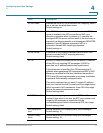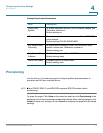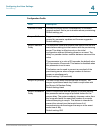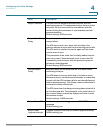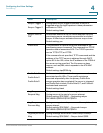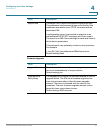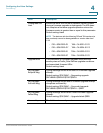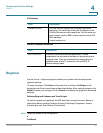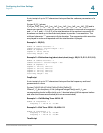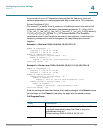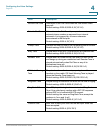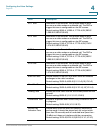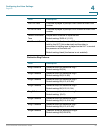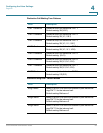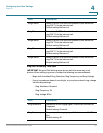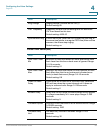
Configuring the Voice Settings
Regional
Cisco SPA232D Administration Guide 81
4
A mini-script of up to 127 characters that specifies the cadence parameters of a
signal.
Syntax: S
1
[;S
2
], where:
S
i
=D
i
(on
i
,1/off
i
,1[,on
i
,
2
/off
i
,
2
[,on
i,3
/off
i
,
3
[,on
i
,
4
/off
i
,
4
[,on
i
,
5
/off
i
,
5
,on
i
,
6
/off
i,6
]]]]]) and is
known as a section, on
i,j
and off
i,j
are the on/off duration in seconds of a segment
and i = 1 or 2, and j = 1 to 6. D
i
is the total duration of the section in seconds. All
durations can have up to three decimal places to provide 1 ms resolution. The
wildcard character “*” represents infinite duration. The segments within a section
are played in order and repeated until the total duration is played.
Example 1: 60(2/4)
Number of Cadence Sections = 1
Cadence Section 1: Section Length = 60 s
Number of Segments = 1
Segment 1: On=2s, Off=4s
Total Ring Length = 60s
Example 2—Distinctive ring (short,short,short,long): 60(.2/.2,.2/.2,.2/.2,1/4)
Number of Cadence Sections = 1
Cadence Section 1: Section Length = 60s
Number of Segments = 4
Segment 1: On=0.2s, Off=0.2s
Segment 2: On=0.2s, Off=0.2s
Segment 3: On=0.2s, Off=0.2s
Segment 4: On=1.0s, Off=4.0s
Total Ring Length = 60s
FreqScript
A mini-script of up to 127 characters that specifics the frequency and level
parameters of a tone.
Syntax: F
1
@L
1
[,F
2
@L
2
[,F
3
@L
3
[,F
4
@L
4
[,F
5
@L
5
[,F
6
@L
6
]]]]
Where F
1
–F
6
are frequency in Hz (unsigned integers only) and L
1
–L
6
are
corresponding levels in dBm (with up to 1 decimal places) White spaces before
and after the comma are allowed (but not recommended)
Example 1—Call Waiting Tone: 440@-10
Number of Frequencies = 1
Frequency 1 = 440 Hz at –10 dBm
Example 2—Dial Tone: 350@-19,440@-19
Number of Frequencies = 2
Frequency 1 = 350 Hz at –19 dBm
Frequency 2 = 440 Hz at –19 dBm
ToneScript



